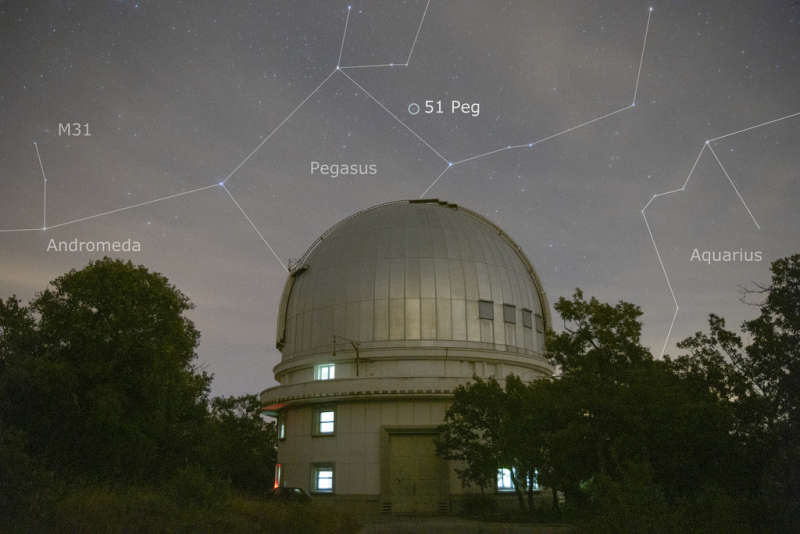Credit & Copyright: Josselin Desmars
Explanation:
It's only
50 light-years
to 51 Pegasi.
That star's position is indicated in this snapshot from
August, taken on a hazy night with mostly brighter stars visible above
the dome at Observatoire de Haute-Provence in France.
Twenty-six years ago,
in October of 1995, astronomers
Michel Mayor
and Didier Queloz
announced a profound discovery made at the observatory.
Using a precise spectrograph they had detected a planet orbiting 51 Peg,
the first known exoplanet orbiting a sun-like star.
Mayor and Queloz had used the spectrograph to measure changes in the
star's
radial velocity,
a regular wobble caused by the gravitational
tug of the orbiting planet.
Designated
51 Pegasi b,
the planet was determined to
have a mass at least half of Jupiter's mass
and an orbital period of 4.2 days,
making it much closer to its parent star than Mercury is to the Sun.
Their discovery was quickly confirmed and Mayor and Queloz
were ultimately awarded the
Nobel Prize in
physics
in 2019.
Now recognized as the prototype for the class of exoplanets
fondly known as
hot Jupiters,
51 Pegasi b was formally
named
Dimidium,
latin for half, in 2015.
Since its discovery, over 4,000
exoplanets
have been found.
1999 2000 2001 2002 2003 2004 2005 2006 2007 2008 2009 2010 2011 2012 2013 2014 2015 2016 2017 2018 2019 2020 2021 2022 2023 2024 2025 |
Yanvar' Fevral' Mart Aprel' Mai Iyun' Iyul' Avgust Sentyabr' Oktyabr' Noyabr' Dekabr' |
NASA Web Site Statements, Warnings, and Disclaimers
NASA Official: Jay Norris. Specific rights apply.
A service of: LHEA at NASA / GSFC
& Michigan Tech. U.
|
Publikacii s klyuchevymi slovami:
extrasolar planet - ekzoplaneta
Publikacii so slovami: extrasolar planet - ekzoplaneta | |
Sm. takzhe:
Vse publikacii na tu zhe temu >> | |
